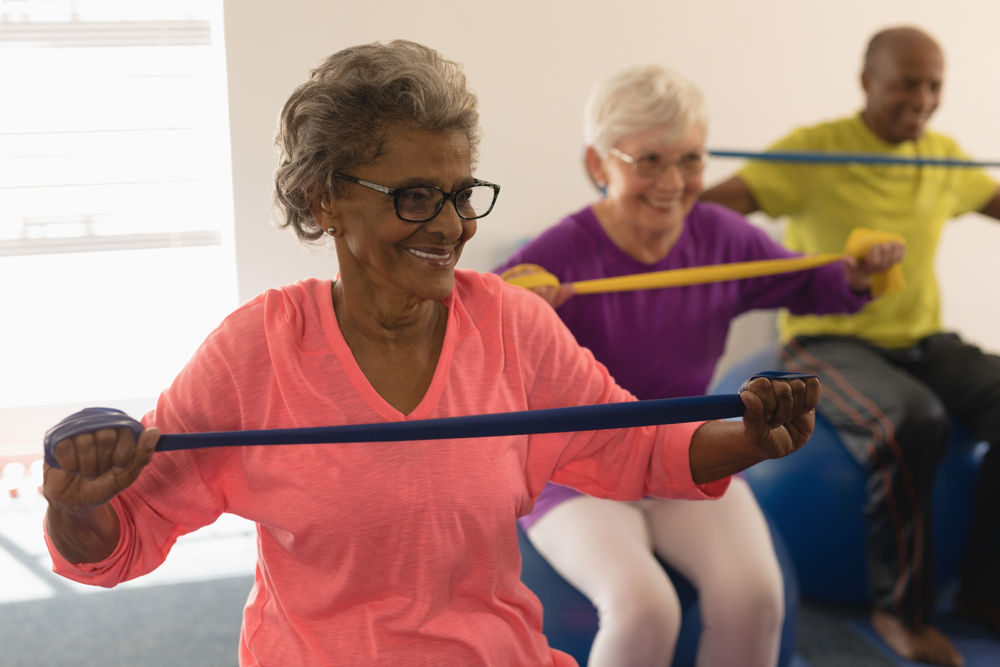Resistance Bands for Seniors: Find out the best exercises to do!
October 26, 2022
If you’re looking for a portable piece of exercise equipment simple enough to exercise at home without taking up any room, or for taking to the park or on trips, look no further than resistance bands.
Exactly what is a resistance band? Imagine a human-sized rubber band made of either latex, rubber tubing or cloth. They’re stretchy enough to allow for controlled movement yet provide enough tension and resistance to give you a great workout. The best part is when you’re done, you can toss them over a door handle, and when you travel, you can stash them in an overnight bag.
Different bands serve different purposes, which we’ll get into later in this blog post. But first, let’s look at three exercises using resistance bands suggested for older adults by Livestrong.com and learn why each one is beneficial to older adults.
3 Resistance Band Workouts to Try Now
1. HIP ABDUCTION (Aim for 2-3 sets of 10-12 reps each)
How to do it:
-
-
- Loop the mini resistance band around your ankles and stand tall with your feet hip-width apart.
- Engage your core and step your left foot out to the side. It should travel laterally, directly away from your body, rather than forward or backward.
- Hold and squeeze your outer thighs for two to three seconds before bringing your left foot back to the center. This is one rep.
- Repeat on the opposite side and alternate for 10 to 12 reps. Complete 2 to 3 sets, resting 30 to 60 seconds in between.
- Why it’s helpful:
- Hip abductions with a mini resistance band isolate your hip abductors (muscles that move your legs outward) and hip adductors (muscles that move your legs inward) and strengthen your hips to improve balance and stability which often decrease with age and make you more prone to falls and injury. This exercise can also be performed seated with the band around the thighs.
- 2. HIP EXTENSION (Aim for 2-3 sets of 10-12 reps each)
- How to do them:
-
-
-
- Loop the mini resistance band around your ankles and stand tall with your feet hip-width apart.
- Step your left foot back at a 45-degree angle, keeping your hips square and facing forward. Avoid rotating your spine. You should feel the tension in your left hamstring and hip.
- Pause for 2 to 3 seconds before bringing your left foot back to the center. This is one rep.
- Repeat on the right side and alternate legs for 10 to 12 reps. Complete 2 to 3 sets, resting 30 to 60 seconds in between.
- Why they’re helpful:
- The staggered stance requires you to engage your core and brace your entire body even your back and arms throughout the movement. In addition to your core, scissor toe taps target your hamstrings and glutes. They may fire up your heart and lungs, too.
- 3. SCAPULAR RETRACTIONS (Aim for 2-3 sets of 10-15 reps each)
- How to do them:
-
-
-
- Loop the mini resistance band around your wrists. Position your arms at a 90-degree angle with your palms facing each other and fingers pointing to the ceiling.
- Brace your core and slowly rotate your elbows outward, squeezing your shoulder blades together. Be careful not to arch your back and keep your tummy tucked tight.
- Squeeze your shoulder blades for 2 seconds before releasing and returning your arms to the starting position. Do 10 to 15 reps and rest for 30 to 60 seconds. Complete 2 to 3 sets.
- Why they’re helpful:
- Your scapula is the bone that connects your humerus (upper arm bone) to your clavicle (collarbone), and the 2 bones are connected by various muscles, ligaments and tendons. When those tissues get weak, it can lead to poor posture, rounded shoulders, protruding neck, as well as neck/shoulder/back pain.
-
Choosing the Right Resistance Band for You
Resistance bands are inexpensive and versatile pieces of exercise equipment, which is why you’ll find them in every fitness center and physical therapy clinic. They come in a variety of lengths, materials and thicknesses (for light, medium and hard resistance). People engaging in resistance training choose bands based on what types of exercises they plan to do, and it’s common to own a set of bands to cover every need.
Here’s a quick look at the most common types of resistance bands:
Best for Lower Body: Mini Latex Bands
- Mini bands are typically 9 inches long and about 2 inches wide. They’re available in a variety of resistance levels (and they come in different colors to designate the level).
- Mini bands are great for hip, thigh and butt strengthening exercises. The band is typically looped around both calves right above both ankles. (Avoid looping any bands directly around your knee joint.)
Most Versatile: Long-Looped Latex Bands
- Long-looped resistance bands are great for just about any workout, because you can use them at full length or double them up to create your own band.
- It’s easy to anchor one end to a sturdy doorknob (or to, say, a stable structure like a steel post in your basement or in a park) for leg or arm exercises, or loop one end under your feet and hold the other end in your hands to perform bicep curls for example.
Best for Upper Body: Latex Tubes with Handles
- By looping the tube under both feet and holding the handles, you can perform a variety of upper body moves like bicep curls as well as other exercises for your arms and chest that improve range of motion and strength.
- While the handles add a level of comfort, they also limit the exercise versatility, so this device should probably be part of a set of bands rather than your only equipment.
Best for Comfort: Cloth Bands
- Instead of rubber, these bands are made of a comfortable stretchy cloth, which some people find easier to work with. Cloth bands are also perfect for those with latex allergies.
- Cloth bands are used exactly like a mini band, but you’ll find they actually deliver more resistance, which many people find beneficial.
Get Ready to Enjoy Your Best Life at FellowshipLIFE
We share your enthusiasm for maintaining your independence, and our wellness programs reflect that philosophy in every way. Explore our MyWellness program and our wonderfully vibrant lifestyle, and then contact us. We’d love to tell you more about each of our communities.




